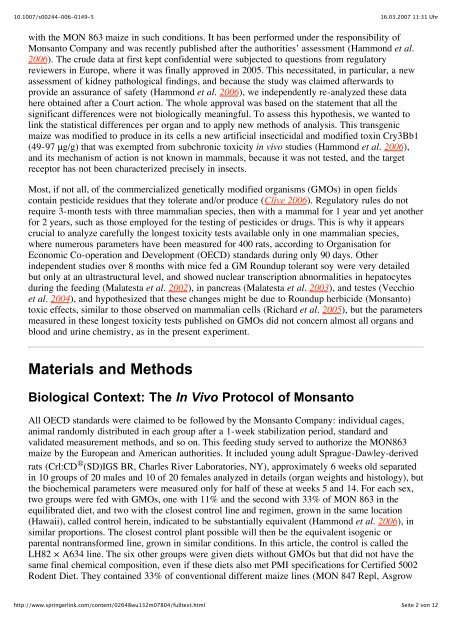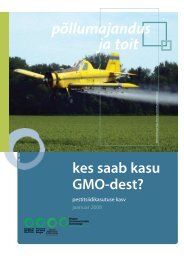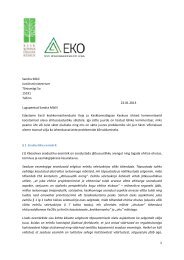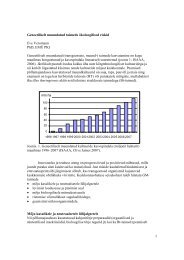New Analysis of a Rat Feeding Study with a Genetically Modified ...
New Analysis of a Rat Feeding Study with a Genetically Modified ...
New Analysis of a Rat Feeding Study with a Genetically Modified ...
Create successful ePaper yourself
Turn your PDF publications into a flip-book with our unique Google optimized e-Paper software.
10.1007/s00244-006-0149-5<br />
16.03.2007 11:31 Uhr<br />
<strong>with</strong> the MON 863 maize in such conditions. It has been performed under the responsibility <strong>of</strong><br />
Monsanto Company and was recently published after the authorities’ assessment (Hammond et al.<br />
2006). The crude data at first kept confidential were subjected to questions from regulatory<br />
reviewers in Europe, where it was finally approved in 2005. This necessitated, in particular, a new<br />
assessment <strong>of</strong> kidney pathological findings, and because the study was claimed afterwards to<br />
provide an assurance <strong>of</strong> safety (Hammond et al. 2006), we independently re-analyzed these data<br />
here obtained after a Court action. The whole approval was based on the statement that all the<br />
significant differences were not biologically meaningful. To assess this hypothesis, we wanted to<br />
link the statistical differences per organ and to apply new methods <strong>of</strong> analysis. This transgenic<br />
maize was modified to produce in its cells a new artificial insecticidal and modified toxin Cry3Bb1<br />
(49-97 μg/g) that was exempted from subchronic toxicity in vivo studies (Hammond et al. 2006),<br />
and its mechanism <strong>of</strong> action is not known in mammals, because it was not tested, and the target<br />
receptor has not been characterized precisely in insects.<br />
Most, if not all, <strong>of</strong> the commercialized genetically modified organisms (GMOs) in open fields<br />
contain pesticide residues that they tolerate and/or produce (Clive 2006). Regulatory rules do not<br />
require 3-month tests <strong>with</strong> three mammalian species, then <strong>with</strong> a mammal for 1 year and yet another<br />
for 2 years, such as those employed for the testing <strong>of</strong> pesticides or drugs. This is why it appears<br />
crucial to analyze carefully the longest toxicity tests available only in one mammalian species,<br />
where numerous parameters have been measured for 400 rats, according to Organisation for<br />
Economic Co-operation and Development (OECD) standards during only 90 days. Other<br />
independent studies over 8 months <strong>with</strong> mice fed a GM Roundup tolerant soy were very detailed<br />
but only at an ultrastructural level, and showed nuclear transcription abnormalities in hepatocytes<br />
during the feeding (Malatesta et al. 2002), in pancreas (Malatesta et al. 2003), and testes (Vecchio<br />
et al. 2004), and hypothesized that these changes might be due to Roundup herbicide (Monsanto)<br />
toxic effects, similar to those observed on mammalian cells (Richard et al. 2005), but the parameters<br />
measured in these longest toxicity tests published on GMOs did not concern almost all organs and<br />
blood and urine chemistry, as in the present experiment.<br />
Materials and Methods<br />
Biological Context: The In Vivo Protocol <strong>of</strong> Monsanto<br />
All OECD standards were claimed to be followed by the Monsanto Company: individual cages,<br />
animal randomly distributed in each group after a 1-week stabilization period, standard and<br />
validated measurement methods, and so on. This feeding study served to authorize the MON863<br />
maize by the European and American authorities. It included young adult Sprague-Dawley-derived<br />
rats (Crl:CD ® (SD)IGS BR, Charles River Laboratories, NY), approximately 6 weeks old separated<br />
in 10 groups <strong>of</strong> 20 males and 10 <strong>of</strong> 20 females analyzed in details (organ weights and histology), but<br />
the biochemical parameters were measured only for half <strong>of</strong> these at weeks 5 and 14. For each sex,<br />
two groups were fed <strong>with</strong> GMOs, one <strong>with</strong> 11% and the second <strong>with</strong> 33% <strong>of</strong> MON 863 in the<br />
equilibrated diet, and two <strong>with</strong> the closest control line and regimen, grown in the same location<br />
(Hawaii), called control herein, indicated to be substantially equivalent (Hammond et al. 2006), in<br />
similar proportions. The closest control plant possible will then be the equivalent isogenic or<br />
parental nontransformed line, grown in similar conditions. In this article, the control is called the<br />
LH82 × A634 line. The six other groups were given diets <strong>with</strong>out GMOs but that did not have the<br />
same final chemical composition, even if these diets also met PMI specifications for Certified 5002<br />
Rodent Diet. They contained 33% <strong>of</strong> conventional different maize lines (MON 847 Repl, Asgrow<br />
http://www.springerlink.com/content/02648wu132m07804/fulltext.html<br />
Seite 2 von 12






